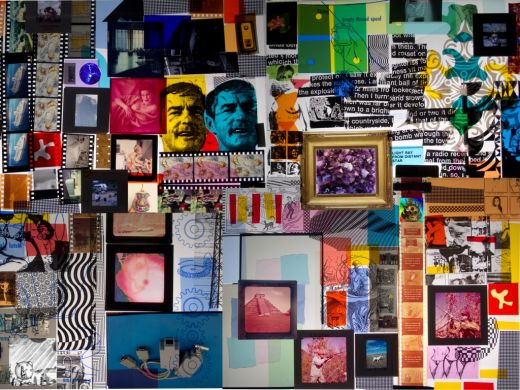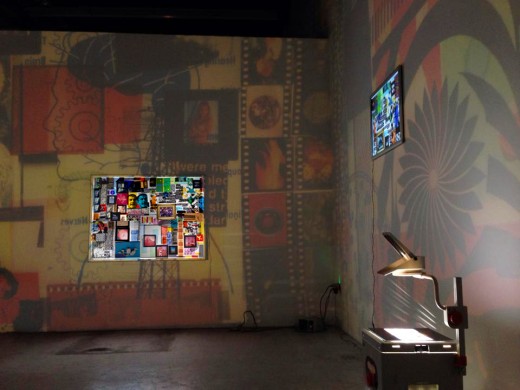- Robert Huff: 47 Years

- Betty Woodman—CONTRO VERSIES CONTRO VERSIA: An inaccurate history of painting and ceramics
Overhead: Kevin Arrow
Hunter Braithwaite

Kevin Arrow, Untitled (analog/digital_1), 2013. Transparent media, Duratrans, light box. 39" x 52" x 8"
November 1 – December 22, 2013
There is a scene in Midnight Cowboy where wannabe cockslinger Joe Buck finds himself at a big city party. The hallucinatory shindig, obviously inspired by Warhol’s Factory, alienates the young hayseed who isn’t sure he wants to be part of this scene. But he is, his ranch-hand manners now branded as camp. I bring this up not only because the party looks similar to Overhead, but because it shows how wholesomeness and deviation are one in the same, because Midnight Cowboy is the only x-rated movie in history to win Best Picture, and because Ratso Rizzo dies on the bus somewhere between Hollywood, Florida and Miami. Kevin Arrow told me that.
Overhead takes place in one room: four white walls cast with a psychedelic collage of found photographs and diagrams, retro graphics, and quirky fields of colored acetate. Each of these wall-sized projections emits from one of four standard 3M overhead projectors stationed along the opposite wall. They are just how you remember them from middle school. Felicitously, Dimensions Variable’s scuffed linoleum floor also takes you back to those afternoons, when pubescent fatigue pushed health class to the astral plane.
Kevin Arrow is a collector, first and foremost. But could we take a moment to remember the wide-ranging uses of that word? How it describes not only those lording over art-filled warehouses and penthouses, but the baseball card kids and the philatelists, storytellers, and hobbyists appearing on the autism spectrum? To the collector, the world makes sense through possession. They are those who, appointed or not, protect. Walter Benjamin said the collector was someone “motivated by dangerous yet domesticated passions.” I think that’s about right.
In his latest exhibition, Arrow beams his collection back into the world. The broadcast images are just shy of identical. To make them, Arrow assembled slide film and other elements on a light table, photographed the arrangement with a mounted digital camera, rearranged, and then rephotographed. In this, the analog world becomes digital (a slight dusting of Photoshop doesn’t hurt) before turning back to the vintage via the projectors.

Overhead installation view.
Although the images that compose Overhead are displayed simply because Arrow possesses them, certain stories come forth. One is the history of the counterculture. The eyes of Timothy Leary, Julian Beck, Harry Smith, and Allen Ginsberg stare out, mouthing “subvert, drop acid”. Another is a bit more Wonder Bread. Arrow also includes images culled from boxes of pedagogical transparencies used for high school science class in the ‘60s.
But to say Arrow brings these worlds together would to imply that they were not already one and the same, which would be wrong. Arrow merely reminds. An example: Betty Page lay entwined with a nude or nearly nude woman, looking out past her double-oh-my cans and hacksaw bangs. A standard piece of vintage bondage erotica—nothing you couldn’t see at the Taschen bookstore on Lincoln Road—but here it finds an uncanny (and uneasy) echo in a frame from Ernie Bushmiller’s Nancy cartoons, in which the eight-year-old, sporting those same bangs, doms over a tied up Aunt Fritzi.
The show has other elements. Arrow’s iPod Mini is plugged in, cycling through its random setting. Friends and performers Jan and Dave activated the space several times with performances. Dimensions Variable takes on the feel of a venue or club, which is fitting because Arrow worked in the 1980s doing visuals for South Beach nightclubs. Many of these images were projected on the walls of The Warsaw Ballroom, Club Nu, and Groove Jet. Overhead can switch on and off, as can the sculptures themselves. The arm can be folded down so that they no longer project, but radiate upwards.
Arrow has said that art should have more than one mode, should be able to do something beyond that which it normally does. The same applies to the collected object. It is awoken or put to sleep simply by turning on a light. Overhead contained a third space, a liminal zone between active and passive. When the music and gallery lights were off but the projectors on, the dreamscape of last century’s image culture beamed onto the opalescent interior of the viewer’s skull. If the act of collecting works like this, and if Benjamin is right, then which is the domesticated part and which the dangerous?









